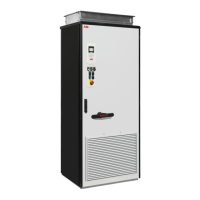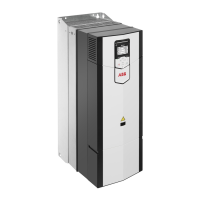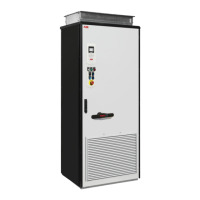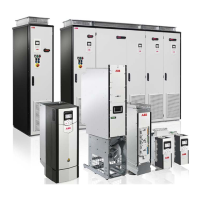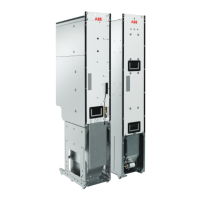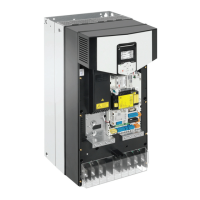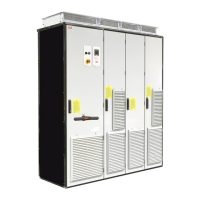Mechanical installation 67
WARNING! Make sure that the incoming air is sufficiently clean. If not, dust goes
into the cabinet. The outlet filter on the cabinet roof prevents dust from going out.
The collected dust can cause drive malfunction and danger of fire.
Air outlet duct on the cabinet roof (option +C130)
The ventilation system must keep the static pressure in the air outlet duct sufficiently below
the pressure of the room where the drive is located in order that the cabinet fans can
produce the required air flow through the cabinet. Make sure that no dirty or moist air is
able to flow backward to the drive in any case, even during off-time or while servicing the
drive or the ventilation system.
Calculating the required static pressure difference
The required static pressure difference between the exit air duct and the drive installation
room can be calculated as follows:
where
Example
The cabinet has 3 exit openings of 315 mm diameter. The rated air flow of the cabinet is
4650 m
3
/h =1.3 m
3
/s.
A
c
= 3 • 0.315
2
• / 4 = 0.234 m
2
v
m
= q / A
c
= 1.3 / 0.234 = 5.5 m/s
p
d
= 0.5 • • v
m
2
= 0.5 • 1.1 • 5.5
2
= 17 Pa
The required pressure in the exit air duct is then, 1.5…2 • 17 Pa = 26…34 Pa, below the
pressure in the room.
For more information, contact ABB.
Arc welding
Fastening the cabinet by arc welding is not recommended. However, if arc welding is the
only mounting option, connect the return conductor of the welding equipment to the
cabinet frame at the bottom within 0.5 meters (1’6”) of the welding point.
Note: The thickness of the zinc coating of the cabinet frame is 100…200 micrometers
(3.94…7.87 mil).
p
d
Dynamic pressure
Air density (kg/m
3
), normally 1.1 kg/m
3
v
m
Average air velocity in the exit duct(s) (m/s)
q
Rated air flow of the drive (m
3
/s)
A
c
Cross-sectional area of the exit duct(s) (m
2
)
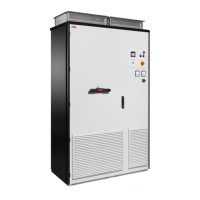
